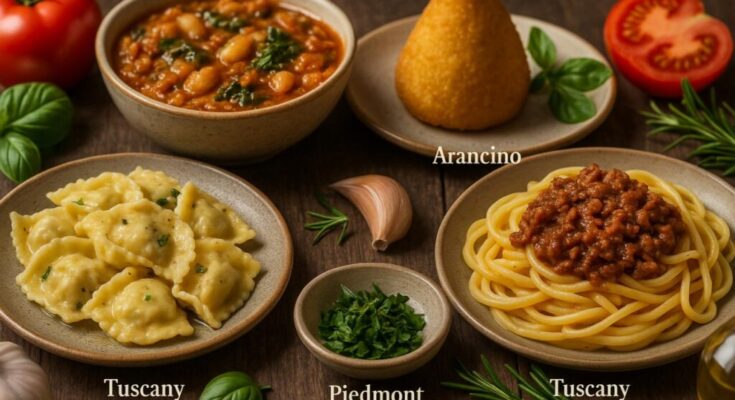Italian cuisine is not a single style of cooking, but rather a rich tapestry of regional traditions, ingredients, and stories. From the sun-soaked coasts of Sicily to the rolling hills of Tuscany, each region of Italy brings its own unique flavor to the table. What unites them is a shared respect for fresh ingredients and a deep cultural connection to food. In this article, we’ll explore how regional diversity has shaped the soul of Italian cooking and why dining at places like Trattoria Gio brings those varied traditions to your plate.
Sicily: A Melting Pot of Mediterranean Influences
Sicily, the largest island in the Mediterranean, offers one of the most diverse and vibrant culinary traditions in Italy. Its food is influenced by centuries of Greek, Arab, Spanish, and North African occupation. As a result, Sicilian dishes often include a rich mix of sweet and savory flavors.
Some signature ingredients in Sicilian cooking include capers, olives, citrus fruits, raisins, pine nuts, and fresh seafood. Dishes like caponata (a sweet-and-sour eggplant stew), arancini (deep-fried rice balls with fillings), and pasta alla Norma (with eggplant and ricotta salata) showcase Sicily’s ability to turn simple ingredients into bold flavors.
Sweet dishes are also a cornerstone of Sicilian cuisine. The world-famous cannoli — crisp pastry tubes filled with sweet ricotta — originated here. So did cassata, a colorful, fruit-laced cake that reflects the island’s multicultural past.
Naples & Campania: The Birthplace of Pizza
Head north to Campania, and you’ll find Naples — the undisputed home of pizza. Pizza Margherita, with its simple combination of tomato, mozzarella, and basil, reflects the colors of the Italian flag and the spirit of simplicity that defines the region’s cuisine.
Campania is also known for its San Marzano tomatoes, buffalo mozzarella, and fresh basil — ingredients that play starring roles in everything from pasta to salads. Dishes like spaghetti alle vongole (clams and garlic in olive oil) and eggplant parmigiana are mainstays here.
The volcanic soil around Mount Vesuvius makes for rich produce, including fragrant lemons used in everything from savory dishes to the region’s famous limoncello liqueur.
Emilia-Romagna: Italy’s Culinary Powerhouse
Often called the food capital of Italy, Emilia-Romagna is the birthplace of many iconic Italian staples. This region gave the world Parmigiano-Reggiano cheese, Prosciutto di Parma, balsamic vinegar from Modena, and fresh egg pasta.
The cuisine here is hearty and indulgent, with dishes like lasagna alla bolognese, tagliatelle al ragù, and tortellini in brodo. The emphasis is on slow-cooked sauces, cured meats, and layered flavors — a testament to the region’s love of craftsmanship in cooking.
Tuscany: Rustic Elegance and Farm-Fresh Simplicity
Tuscany’s cuisine is deeply rooted in the land. It’s known for its rustic and straightforward approach, often referred to as cucina povera — or “peasant cooking” — which emphasizes seasonal produce, legumes, and bread.
Tuscany is famous for dishes like ribollita (a hearty vegetable and bread soup), panzanella (a bread and tomato salad), and bistecca alla fiorentina (a massive, grilled T-bone steak). Olive oil from this region is especially prized, and it features prominently in nearly every dish.
The wines of Tuscany, such as Chianti and Brunello di Montalcino, pair beautifully with its robust, earthy flavors.
Piedmont to Puglia: Diversity Across the Map
From the creamy, truffle-laced dishes of Piedmont in the north to the olive oil-rich, vegetable-heavy fare of Puglia in the south, Italy’s culinary map is full of contrasts. Piedmont showcases French-influenced dishes like vitello tonnato and agnolotti, while Puglia celebrates grilled vegetables, orecchiette pasta, and sun-dried tomatoes.
One Table, Many Stories
What makes Italian cuisine truly special is how every region tells a different story — through its landscapes, its people, and its food. Restaurants like Trattoria Gio bring those stories together, offering diners a taste of Italy’s diverse regions all in one menu.
Whether it’s the spicy kick of Sicilian pasta, the elegance of Tuscan olive oil, or the comforting warmth of Bolognese ragù, each dish carries the soul of its region. And when shared with others, it becomes more than a meal — it becomes a journey through Italy’s culinary heartland.




